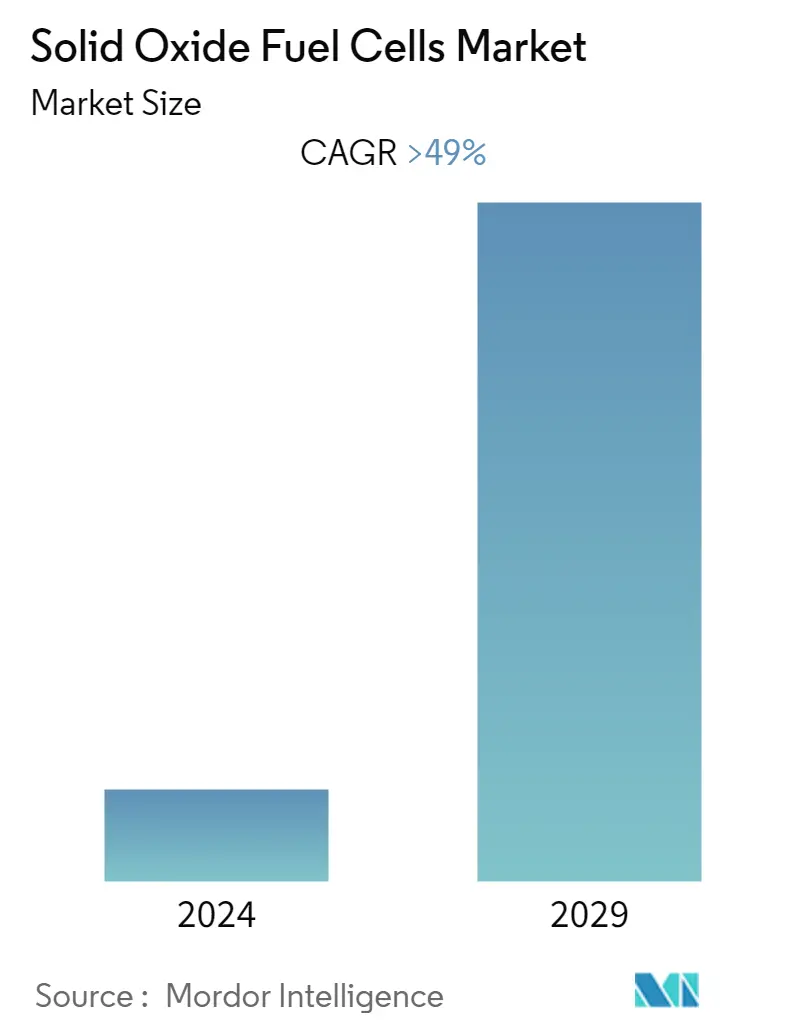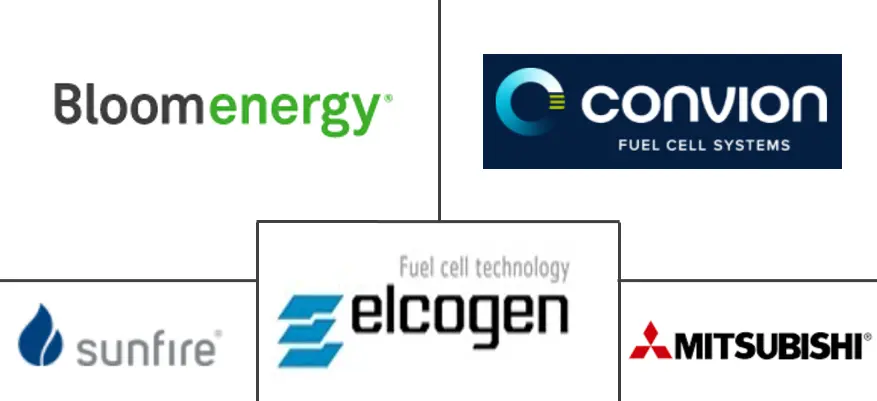Market Size of Solid Oxide Fuel Cells Industry

| Study Period | 2020 - 2029 |
| Base Year For Estimation | 2023 |
| CAGR | 49.00 % |
| Fastest Growing Market | Asia Pacific |
| Largest Market | North America |
| Market Concentration | High |
Major Players
*Disclaimer: Major Players sorted in no particular order |
Solid Oxide Fuel Cells (SOFC) Market Analysis
The solid oxide fuel cell (SOFC) market is expected to witness a CAGR of more than 49% during the forecast period.
COVID-19 negatively impacted the market in 2020. Presently the market is likely to reach pre-pandemic levels.
- Over the long term, the SOFC market is likely to grow in the future due to the energy conversion efficiency of the cells compared to other power generation sources and long-term stability.
- However, the market can be constrained due to the high cost of the technology compared to alkaline fuel cells.
- Non- Vehicular segment is expected to dominate the market in the coming years due to the demand for stationary high-temperature applications.
- Nevertheless, the technological milestones create ample opportunities for the market. For instance, Phillips 66 Company received a USD 3 million grant from the US Department of Energy (DOE) to develop high-performance reversible solid oxide fuel cells. The company will collaborate with the Georgia Institute of Technology to demonstrate the feasibility of this system for hydrogen and electricity generation.
- The Asia-Pacific region is likely to have the major share in this evolving scenario due to the favorable government policies for cleaner power supply sources.
Solid Oxide Fuel Cells (SOFC) Industry Segmentation
A fuel cell is an electrochemical cell that converts fuel into electricity. Every fuel cell has two electrodes (anode and cathode) that help produce electricity. In Solid Oxide Fuel Cell (SOFC), the cathode converts oxygen molecules to oxygen ions. Then, the electrolyte allows the passage of the oxygen ions toward the anode preventing the progression of electrons. At the anode, oxygen ions react electrochemically with fuel, release electrons to an external circuit, and produce electricity. SOFC Market is Segmented by Application (Vehicular and Non-Vehicular) and Geography (North America, Europe, Asia-Pacific, South America, Middle-East, and Africa). For each segment, the market sizing and forecasts have been done based on revenue (USD million).
| Application | |
| Vehicular | |
| Non-Vehicular |
| Geography | |
| North America | |
| Europe | |
| Asia-Pacific | |
| South-America | |
| Middle-East and Africa |
Solid Oxide Fuel Cells Market Size Summary
The solid oxide fuel cells (SOFC) market is poised for significant growth, driven by the technology's superior energy conversion efficiency and long-term stability compared to other power generation sources. Despite the initial setback due to the COVID-19 pandemic, the market is rebounding and is expected to reach pre-pandemic levels. The non-vehicular segment is anticipated to lead the market, fueled by the increasing demand for stationary high-temperature applications. However, the high cost of SOFC technology compared to alternatives like alkaline fuel cells may pose challenges. Technological advancements, such as the collaboration between Phillips 66 Company and the Georgia Institute of Technology, are creating new opportunities, particularly in the development of high-performance reversible SOFCs for hydrogen and electricity generation. The Asia-Pacific region is expected to dominate the market, supported by favorable government policies promoting cleaner energy sources.
SOFCs are particularly well-suited for stationary power generation systems, including combined heat and power (CHP) systems, due to their high-quality heat supply, electrical efficiency, and flexibility in fuel use. These systems are gaining traction in residential and commercial sectors, with companies like Cummins Inc. and Bloom Energy Solutions advancing the commercialization of SOFC technology to reduce carbon footprints and enhance energy resilience. The technology's adoption is further bolstered by initiatives in China and Japan, where government support and incentives are driving the integration of fuel cells into the energy mix. The market is characterized by fragmentation, with key players such as Mitsubishi Hitachi Power Systems Ltd, DuPont de Nemours Inc., and Bloom Energy Corp. actively contributing to its development. Recent projects, like South Korea's first SOFC power plant, highlight the growing interest and investment in this technology, underscoring its potential to meet energy demands while minimizing environmental impact.
Solid Oxide Fuel Cells Market Size - Table of Contents
-
1. MARKET OVERVIEW
-
1.1 Introduction
-
1.2 Market Size and Demand Forecast in USD billion, till 2028
-
1.3 Recent Trends and Developments
-
1.4 Government Policies and Regulations
-
1.5 Market Dynamics
-
1.5.1 Drivers
-
1.5.2 Restraints
-
-
1.6 Supply Chain Analysis
-
1.7 Porter's Five Forces Analysis
-
1.7.1 Bargaining Power of Suppliers
-
1.7.2 Bargaining Power of Consumers
-
1.7.3 Threat of New Entrants
-
1.7.4 Threat of Substitutes Products and Services
-
1.7.5 Intensity of Competitive Rivalry
-
-
-
2. MARKET SEGMENTATION
-
2.1 Application
-
2.1.1 Vehicular
-
2.1.2 Non-Vehicular
-
-
2.2 Geography
-
2.2.1 North America
-
2.2.2 Europe
-
2.2.3 Asia-Pacific
-
2.2.4 South-America
-
2.2.5 Middle-East and Africa
-
-
Solid Oxide Fuel Cells Market Size FAQs
What is the current Solid Oxide Fuel Cells Market size?
The Solid Oxide Fuel Cells Market is projected to register a CAGR of greater than 49% during the forecast period (2024-2029)
Who are the key players in Solid Oxide Fuel Cells Market?
Bloom Energy Corp. , Sunfire GmbH , Elcogen SA, Convion Ltd and Mitsubishi Hitachi Power Systems Ltd are the major companies operating in the Solid Oxide Fuel Cells Market.

